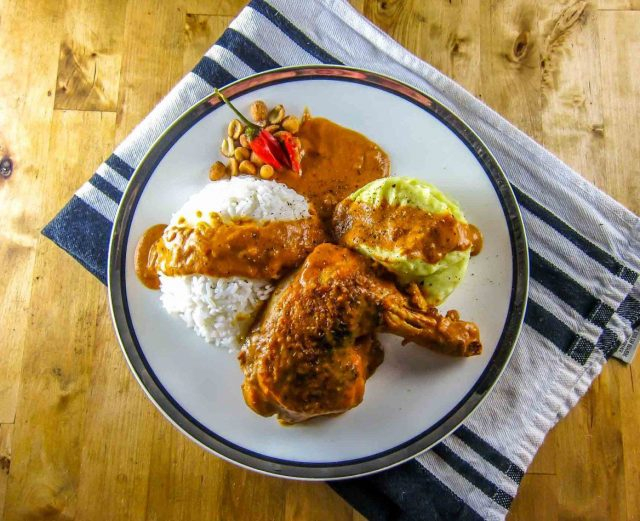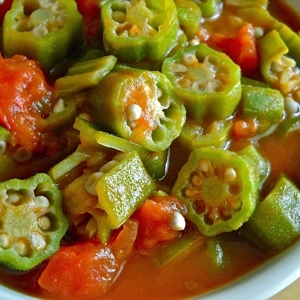Researching Congolese Food for a book I was once thinking of writing, I became entranced by the simple ingredients they use in the Congo to come up with such a wide variety of dishes. Unlike staple foods we’ve come across on previous culinary expeditions here at the FFB, many of the Congo’s are truly ancient…
 Poulet à la Moambé (Mwambe Chicken): One of
Poulet à la Moambé (Mwambe Chicken): One of
the most popular main dishes in the Congo.
As underdeveloped countries go, the Congo is one of the most primitive – once you get out of the big cities. You’d expect places like the Interior of the Congolese jungle, wildest Borneo and the depths of the vast Amazon rain forests to produce reports of subsistence diets consisting of Rice, a few bits of local fish or chicken, and starchy staples such as Taro, and whatever other native foods can be found in the local woods. Okay. That’s true of the Congo, too, but eons of living where they do have allowed the Congolese to try just about everything they have available in their forests and have come up with some truly amazing combos of ingredients prepared in traditional styles…
What are those ingredients, anyway?
Chicken is a principle meat, along with catfish caught in the muddy rivers of the Congo.
Goat and and Pork are also occasionally but regularly seen.
Peanuts and lentils are popular legumes in the region, prepared in a variety of ways. Did you know Peanut Butter is native to Central Africa?
Where you find peanuts, you’ll probably also find Okra, served boiled or fried, by itself or simmered in soups or stews to thicken them.
Tomatoes are commonly grown, as are onions, and peppers.
That’s just a sampling of the most common and popular ingredients found in the most popular Congolese foods. Go on and get Googling to find out what other interesting and exotic constituents you’ll find in the country’s unique national cookbook!
On our menu today…
Known in various regions as poulet nyembwe, muamba de galinha, and nyembwe or mwambe chicken, this simmered dish is less a Stew than a one-pot dinner. So popular is it in central Africa that’s not only the national dish of the Congo but of Angola and Gabon as well. It’s basically chicken with spices, which simmer up into a spicy sauce. Typically served over plain rice with a boiled, puréed cassava dish known as saka saka, it’s welcome on Congolese supper tables anytime.
Fufu: Again, this dish is popular throughout Central Africa. It’s like a porridge made of cassava, plaintains or yams. Boil well, then purée and form into small round balls. Like Boiled dumplings, Fufu is often eaten with soups or stews. And you’re going to discover that Congolese, and Central African cuisine in general, features a lot of soups and stews!
Kwanga is a raised bread that is made from fermented cassava root and baked or steamed, wrapped up in a rolled-up banana leaf. Are you beginning to see, now why Banana leaves are included in the ingredients list? Unlike Fufu, it’s customarily served hot as a side with stews or soups.
Dabo Kolo is a popular festive finger food (vaguely finger-shaped) that’s native to Ethiopia but also popular across the Congo. It’s a baked bread product made with barley, peanuts and chickpeas, and features a beautiful golden brown colour.
Mikate is a fried bread, but a raised one, made with flour, eggs, yeast, and butter. It’s also known as puff puff, bofrot, and kala depending where in the Congo you are. The deluxe version is dipped i peanut butter and sprinkled with white sugar.
Fumbwa: That’s the Congolese name of a wild spinach found across the region. It’s also the name of a veggie stew made from the spinach, plus onions and tomatoes. Those who’ve had it say it has a look and a flavour like you’ve never experienced before. It may also contain chunks of catfish to make it a full meal. Sere with fried plantains or fufu.
Ngulu Yako Tumba is a grilled street food consisting of cubes of spiced skewered goat or pork. It’s usually topped with grated cheese and served with a spinach salad on the side. Other accompaniments may also be present.
Dongo-Dongo is a typical Congolese soup or stew (depending on how much okra you put in oy). May also be enhanced with meat or fish (whatever you have on hand). It’s recommended that one eats it with Fufu or Rice. Give me Rice with this luscious concoction any day.
And finally: the Congolese Blue Plate Special: Rice served alongside grilled meat (whatever you have on hand) a rich stew made principally of beans, red bell peppers, red chili peppers and tomato paste. Choose a selection of spices and herbs that complements your meat and bean components.
In summation…
A simple, but dramatic and colourful cooking style highlighted by its (often cassava-based) starches, Congolese cuisine celebrates its jungle heritage in a surprising number of ways!
*
Special thanks to: Jay Shelton, who describes himself as a full-time traveller and part-time food writer. He estimates he’s covered more than 500 days tramping the world since he started his endless journey several years ago.
~ Maggie J.

